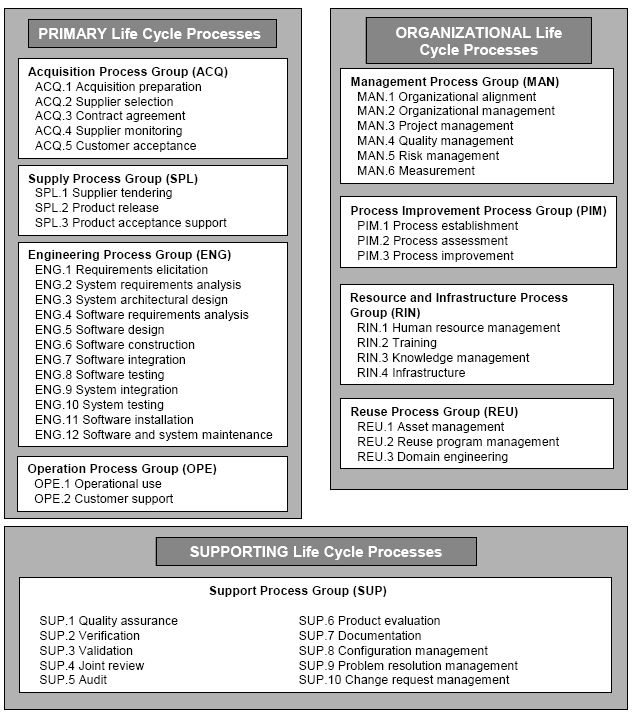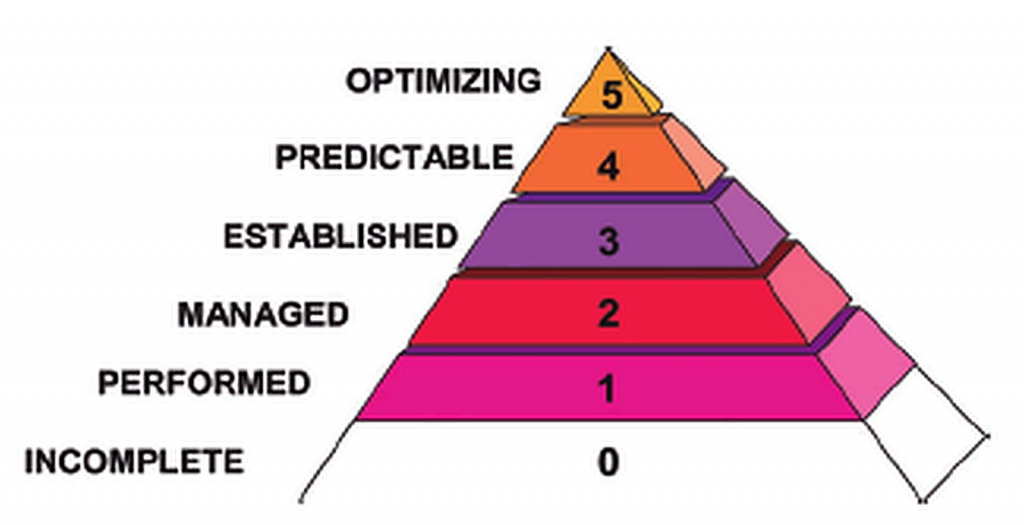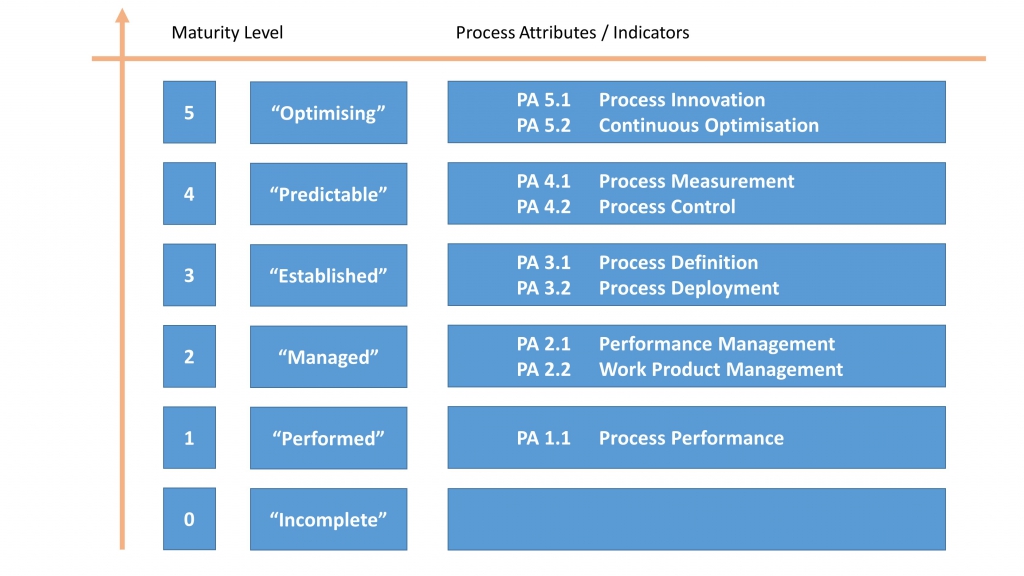ISO/IEC 15504 — SPiCE
History of ISO/IEC 15504
ISO/IEC 15504 — also known as SPiCE (Software Process Improvement and Capability dEtermination) is an international norm of the ISO-Institute to assess and evaluate the business processes of software and electronic development (embedded systems).
SPiCE initially stood for "Software Process Improvement and Capability Evaluation", but in consideration of French concerns over the meaning of "evaluation", SPiCE has now been renamed "Software Process Improvement and Capability Determination". SPiCE is still used for the user group of the standard, and the title for the annual conference.
Subject of ISO/IEC 15504 is the assessment of software development processes and related assessment requirements, as well as the application of the norm.
The process reference model (PRM) of ISO/IEC 15504 defines the central processes being relevant to be assessed in any software embedded system development. The process assessment model (PAM) defines how the capability of the processes in the organisation should be evaluated.
ISO/IEC 15504 is the European equivalent of the US maturity model Capability Maturity Model Integration (CMMI).
Evolution of ISO/IEC 15504
Technical Report Released
ISO/IEC 15504 was pre-released 1998 as technical report (TR) of a project of the Joint Technical Subcommittee between the ISO and the IEC organisations.
International Standard Released
Since 2003/2004 the technical report was substituted by the international standard (IS) incrementally.
Currently 2015 the standard consists of 10 parts. But, only the second part is normative. The remaining parts have illustrative, exemplar, and informational character only.
- ISO/IEC 15504-1:2004 — Part 1: Concept and vocabulary — general introduction into the notion of process assessments and a glossary of assessment related terminology.
- ISO/IEC 15504-2:2003 — Part 2: Performing an assessment — minimal requirements to perform an assessment to get consistent and repeatable evaluations; part 2 is the (normative) core of the norm, the others have more interpretative character.
- ISO/IEC 15504-3:2004 — Part 3: Guideline to perform assessments — guide to interpret the assessments requirements defined in part 2 to perform assessments.
- ISO/IEC 15504-4:2004 — Part 4: Guideline to apply process improvement and process assessments — guide to perform process assessments in a process improvement program or process capability evaluation.
- ISO/IEC 15504-5:2012 — Part 5: Example of a process assessment model — example of a process assessment model to perform assessments in compliance to the requirements stated in part 2.
- ISO/IEC TR 15504-6:2008 — Part 6: An exemplary system life cycle process assessment model — Based on the requirement PAM of system life cycle processes in ISO/IEC 15504-2, exemplary guidance is provided in this part. This part also describes the overall structure of the PAM and the capability dimension from ISO/IEC 15288 and ISO/IEC 15504-2 respectively.
Apart from this, this part also provides detailed descriptions of work products and steps for defining additional assessment indicators. - ISO/IEC TR 15504-7:2008 — Part 7: Assessment of organisational maturity — Organisational maturity relates to the degree the organisation implements processes, in order to achieve its business goals, within a defined scope. ISO/IEC 15504-7:2008 defines the conditions for the assessment of organisational maturity and provides a framework which helps to conduct assessments of organisational maturity.
- ISO/IEC TS 15504-8 — Part 8: An exemplar process assessment model for IT service management — This technical specification (TS) is a prelimanry version of a process assessment model of the norm. The fundamental processes are compliant to ISO/IEC 20000.
With this it is possible to assess a capability level for these indivuals processes and an organisational maturiy level. - ISO/IEC TS 15504-9:2011 — Part 9: Target process profiles — This technical specification (TS) is a prelimanry version of the norm describing target process profiles.
- ISO/IEC TS 15504-10:2011 — Part 10: Safety extension — This technical specification (TS) is a prelimanry version of the norm covering safety issues.
ISO/IEC 15504 Process Reference Model
ISO/IEC 15504 defines in a reference model the central processes relevant to be inspected and to be performed in any software/embedded system development.
The process reference model of ISO/IEC 15504 defines the processes of a product development project at three distinct organisational levels:
- Primary Life Cycle Processes: central processes for technical product development.
- Organisational Life Cycle Processes: organisation-wide processes for project support.
- Supporting Life Cycle Processes: individual processes for project support.
The ISO/IEC 15504 engineering processes stated in part 5 are software-centered. Thus, after the official release several process assessment models and extensions of process reference model were developed for othe application domains:
- Automotive: Automotive SPICE
- Medicine: Medi SPICE
- Testing: Test SPICE
- Space Technology: S4S - SPICE for SPACE Part 1: Framework, Part 2: Assessor instrument, ESA bulletin 107
- Tailoring and Extension: SPiCE in Action - Experiences in Tailoring and Extension
ISO/IEC 15504 Process Assessment Model
The process assessment model (PAM) relates to the process reference model of ISO/IEC resp. compatible reference models. It defines how to evaluate the capability of processes within an organisation.
The assessment model shows the details — so-called process indicators — to evaluate the process capability It is organised in two dimensions:
- Process Dimension: this dimension defines for all processes fundamental indicators to evaluate the capability of a process: base practices and work products.
- Capability Dimension: this define defines more indicators to evaluate the capability of a process: generic practices, generic resources and generic work products.
Any process can show an individual capability level independent to other processes. ISO/IEC 15504 uses in — CMMI terminology — a continuous maturity level model.
Maturity Levels
Part 2 of the norm defines six maturity levels (identical to CMMI Continuous Representation):
Maturity Evaluation
To evaluate whether a certain process maturity level is existent is determined with process attributes. The process attributes are aligned with maturity levels and characterise them by content.
Each process attribute defines in form and content certain aspects of process maturity. For example, maturity level 2 is defined by the attributes "Performance Management", i.e., planning, assigning, and monitoring of responsibilities and resources — and "Work Product Management", i.e. assuring that the work product requirements and objectives are fulfilled.
The realisation of process attributes are measured on a 4-staged measurement scale:
N — Not achieved
P — Partially achieved
L — Largely achieved
F — Fully achieved
The maturity level is determined by the process attribute measurements:
To achieve a certain maturity level all process attributes of the level in question have to be realised at least as "L" and all attributes of all levels below have to be "F".
ISO/IEC 15504 Assessments
The ISO/IEC 15504 prescribes not strict assessment regulations (like SCAMPI method in CMMI). Rather, it defines in part 2 basic, minimum set of requirements only to run ISO/IEC 15504 compliant assessments.
These minimum set of requirements assure that the assessment results are objective, neutral, consistent, repeatable, and representative for the processes evaluated.
Part 3 ("Guidance on performing an assessment") is a a guideline to part 2. It describes in detail how to perform assessments.
Further Reading
[amazon_search design="2" width="300" market_place="" color_theme="Default" default_search_term="ISO 15504" search_index="All" columns="1" rows="3" outer_background_color="##BDBDBD" inner_background_color="" background_color="##BDBDBD" border_color="" header_text_color="#000000" linked_text_color="#365DA0" body_text_color="" shuffle_products="True" show_image="True" show_price="True" show_rating="True" rounded_corners="False"/]










Leave A Comment